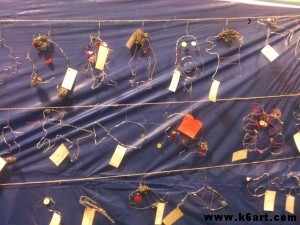This year our art show featured a famous artist scavenger hunt – with a special twist : we used smartphones and QR codes to discover facts about famous artists.
What are QR codes?
Some of you reading this are very familiar with QR (Quick Response) codes, but many are not. QR codes are square, black and white, pixellated computer-generated images. You need a smartphone (or camera-equipped iPod touch or iPad) plus a free scanner app to read a QR code.
What happens when you ‘read’ (scan) a code with your smartphone?
Your smartphone opens to a new website, or displays text of your choice.
How To Read a QR code:
- download a free scanner app (we use Red Laser) to your device
- scan the QR code
Example:
Here is the text you get when you scan QR code 8 above:
‘Pablo Picasso was born in Spain. He painted every day of his adult life. He is famous for his Cubist artworks. Kindergarteners made collage portraits inspired by Picasso’s unusual portraits.’
If you are reading this and own a smartphone, pull up this post on a laptop or computer and give it a try. I was actually able to scan my own computer screen using the Red Laser app.
How to generate your own QR codes (its easy and free):
Google ‘QR code generator’. We liked the websites http://qrcode.kaywa.com/ and http://www.qrstuff.com/
The generators allow you to add your own text. We entered a brief 250-character statement about each famous artist, and then generated the code.
Why?
Our school is piloting a 1:1 iPad/iPod touch program in the 4th grade. The entire grade is utilizing the devices in the classroom. I thought the QR code scavenger hunt would be a fun way to integrate technology with art education, to get parents involved with technology, and just to have a fun family activity at the art show. Many parents were completely unfamiliar with codes – it was great to see kids showing their parents how to read them.
Learn More about QR codes and art ed:
I originally learned about QR codes in art education from The Teaching Palette and Mini Matisse. Thanks!
What about those famous artists? Check out our scavenger hunt form:
We studied 10 artists this year. Click on the links to see the lesson plans.
1. Dale Chihuly 2. George Seurat 3. Alexander Calder 4. Claude Monet 5. Diego Rivera 6. Amadeo Modigliani 7. Wayne Thiebaud 8. Pablo Picasso 9. Wassily Kandinsky and 10. Henri Matisse
Thanks to:
Two (awesome!) fourth graders, Max and Arman, generated the QR codes for all 10 famous artists for the 2012 art show, our 4th grade teachers, and fabulous parent volunteer M.B.G., who prepared all the forms and signage for the scavenger hunt.












